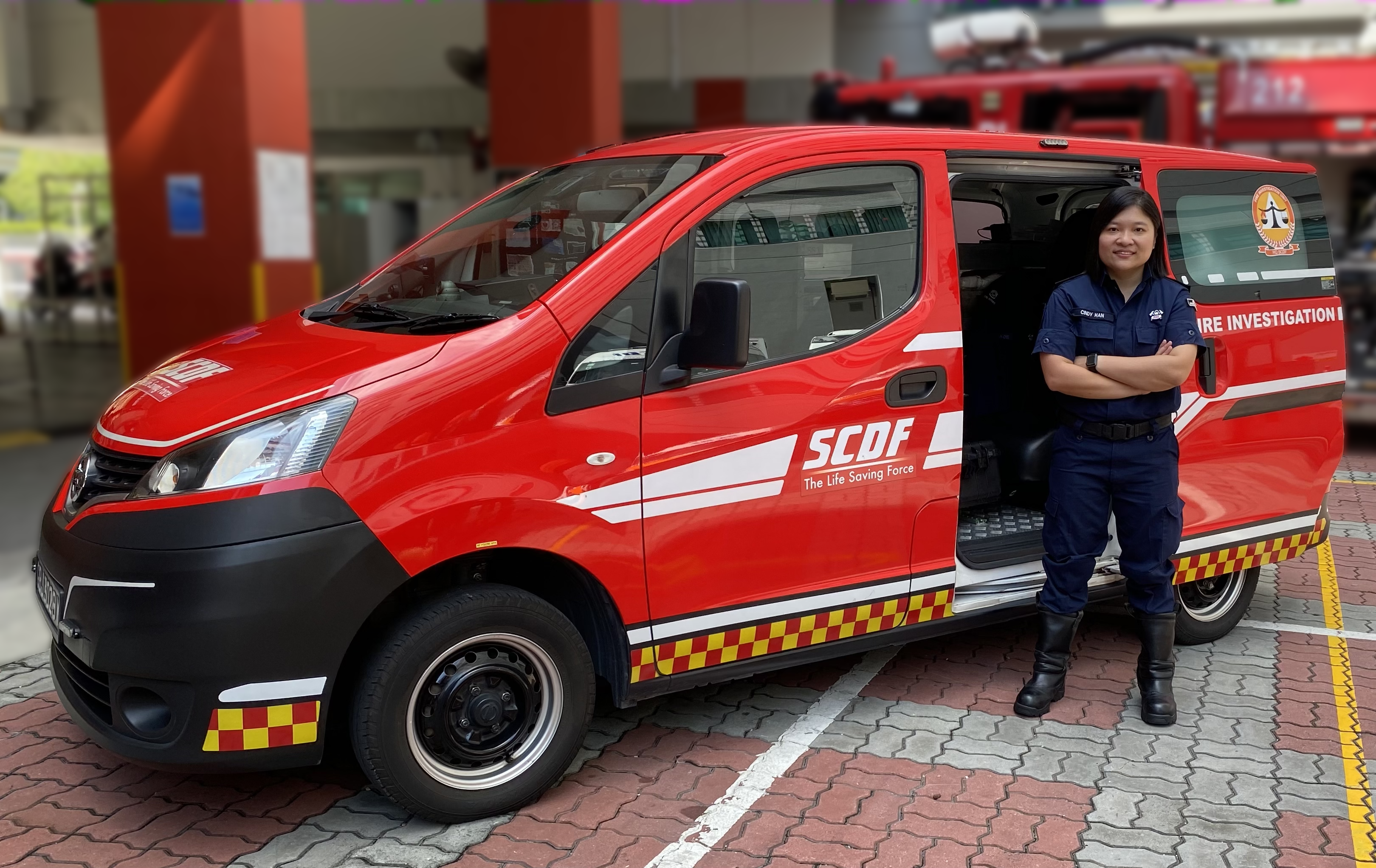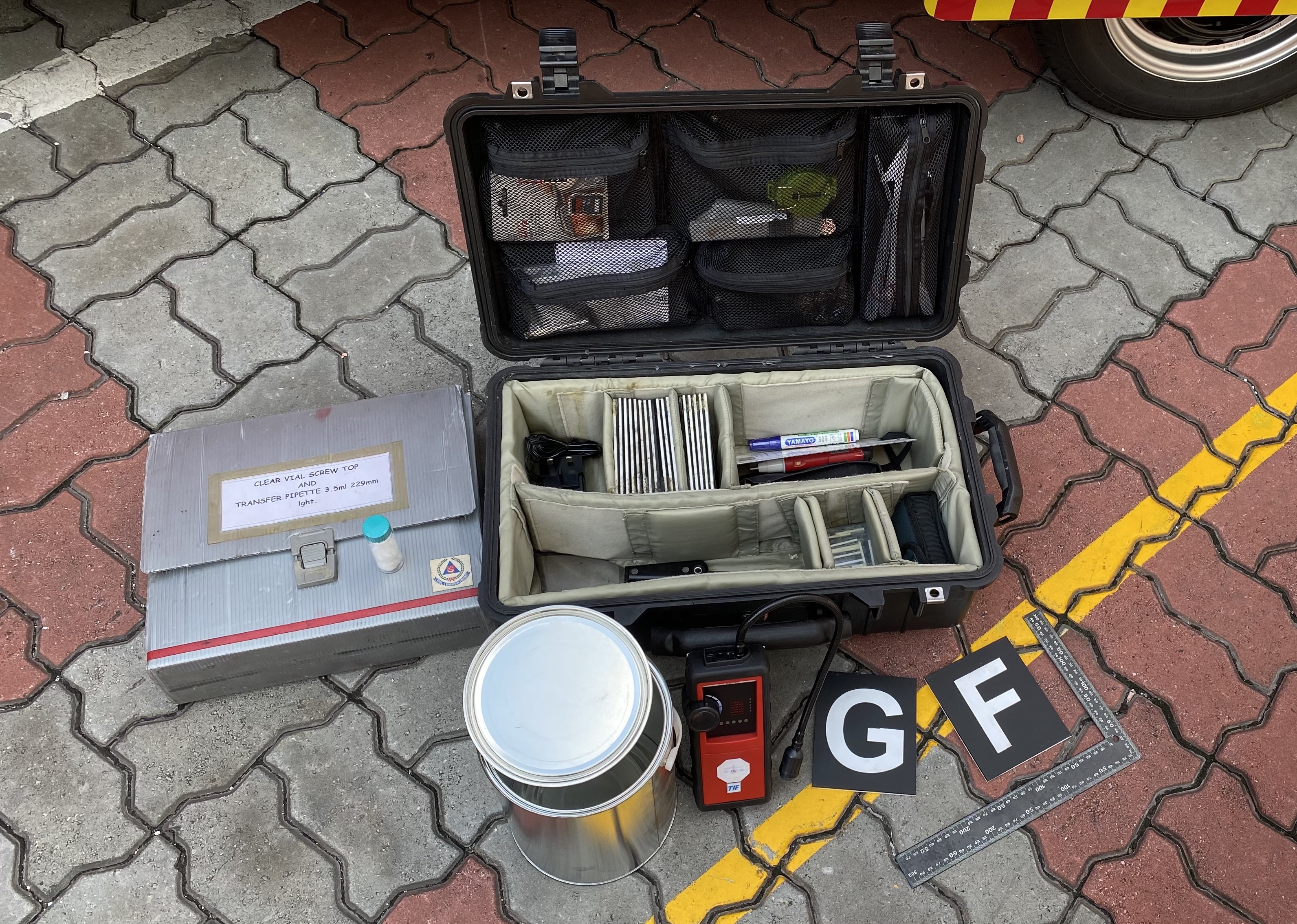You may have seen how firefighters extinguished fires and saved lives of those trapped in burning buildings. But do you know what comes next for SCDF after the fire is put out? It is investigation in getting to the root cause of the fire.
Fire investigators will enter the post-fire scene to collect evidences to determine the origin and cause of fire. At times, they work with other public sector agencies to establish ways to reduce future fire occurrences and, where applicable, assist the
police in criminal prosecution. They would also assist the affected parties in claim recovery based on the findings from the evidences collected at the fire scene.
Rescue 995 engaged Captain (CPT) Cindy Han Chai Yee, a Senior Fire Investigator with the SCDF Fire Investigation Unit (FIU), in an exclusive interview.
 Captain (CPT) Cindy Han and the SCDF Fire Investigation Vehicle
Captain (CPT) Cindy Han and the SCDF Fire Investigation Vehicle
Rescue 995: What are your roles and responsibilities as a fire investigator?
CPT Cindy: In SCDF, fire investigation is largely carried out by officers from the fire stations. I, as a senior fire investigator, including my FIU colleagues will investigate complex cases. These cases usually consist of major fire incidents
or fires involving fatalities and may take a longer time to determine or solve.
Rescue 995: How do you and your FIU team work at the fire scene?
CPT Cindy: There are four teams in FIU and each team works in pairs. When we are activated to the fire scene, an investigator will be combing and gathering on-site evidences while another investigator will be busy conducting interviews with
affected parties to identify the possible cause of the fire.
Rescue 955: Some fire cases are complex in nature. Share with us the challenges you encountered in investigating such cases and how are they are typically solved.
CPT Cindy: I remember attending to a case at Tuas Crescent involving a waste management plant. It was a complex case because the damage to the property was very severe and extensive. Most parts of the building had collapsed after the fire
was extinguished. As a result, we had to wait for the debris to be cleared before we could gain access into the incident site to conduct a thorough fire investigation. The entire process may take several weeks.
One of the challenges encountered is that during this period of waiting, the tropical weather could have affected the findings, especially when the evidence involves chemicals which may have reacted with or washed by the rainwater. Another challenge is
when the fire is so massive that there is hardly any trace of evidence left. They are either lost in the flames or buried deep under the debris.
In such a situation, to aid us with our findings, we embark on a slew of measures such as leveraging the company’s building layout plan to find consistency with what we observed and found at the scene, retrieving CCTV footages from nearby premises,
and interviewing eyewitnesses to find clues on the cause of the fire. During the investigation process, we as fire investigators are trained to be very objective and inquisitive, leaving no stone unturned and will disprove possible hypotheses that
are inconsistent. This is how we typically determine the cause of fire and conclude a case.
.jpg?sfvrsn=d78e3ff_3)
Rescue 995: What are some of the equipment or devices used in fire investigation?
CPT Cindy: To test for presence of an accelerant, we use the combustible gas detector to detect the remnants of flammable vapours at the scene. Sometimes, the fire investigation dogs will be activated to sniff out any remaining presence
of flammable vapours. After collecting the evidences, they will be processed at the laboratory.
These days, with the advancement in technology, we now deploy drone and terrestrial scanner that utilise photogrammetry and laser beam to capture scene details with increased precision and accuracy. This enabled investigators to have a 360-degree panoramic
view of the scene, revisit the scene digitally when required, and reconstruct the scene for simulations and fire modelling. Such data is useful in supporting our investigation.
 [From the top, left to right]A grey kit containing vials for collecting liquid samples at the burnt sites and evidence kit containing tools to extract solid samples as evidence at burnt sites. [From bottom, left to right] Metal container for collecting solid samples for laboratory testing, combustible gas detector, placards for identification of evidence and a ruler for measurement.
[From the top, left to right]A grey kit containing vials for collecting liquid samples at the burnt sites and evidence kit containing tools to extract solid samples as evidence at burnt sites. [From bottom, left to right] Metal container for collecting solid samples for laboratory testing, combustible gas detector, placards for identification of evidence and a ruler for measurement.
Rescue 995: Recently, a virtual fire investigation training simulator has been introduced at the SCDF’s Civil Defence Academy. Tell us more about this training simulator?
CPT Cindy: The virtual fire investigation training simulator literally takes fire investigation training to the next higher level. The sophisticated state-of-the-art virtual simulator allows for the depiction of simulated sensory-rich scenarios.
It is so realistic as if you are indeed at an actual fire scene where you could put your theoretical knowledge into good use under varied scenarios. For instance, in one scenario, you will have the option to take some photos of the evidence and your
trainer will provide direct, real-time feedback on how you can do better when detecting clues at the fire scene.
Such virtual training paves the way for more opportunities to realistically apply what you learned in the classroom setting. Above all, it cuts down the time, efforts and resources needed for classroom demonstration purposes.
Rescue 995: What do you think are the key contributions of a fire investigator in relation to SCDF’s mission to protect and save lives and property?
CPT Cindy: After a fire, lives can be endangered or disrupted. There will also be unanswered questions and concerns as to the cost and extent of damage. To lessen the impact of the loss, the data and findings that we gathered as fire investigators
will provide a form of closure for the affected parties. In addition, knowing the cause of fire through our investigation provides SCDF with the needed information to educate the public on fire safety advisories and fire prevention tips. That, to
me, is my contribution to The Life Saving Force.